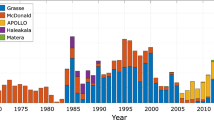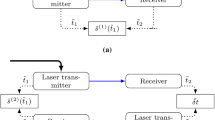Abstract
The analysis of range or Doppler data between sites on the Earth and Moon requires an accurate computation of the lunar orbit and detailed models of the orientation of the Earth and Moon. Models constructed to understand range and range rate can lack detail, but if they include the largest lunar orbit variations, tracking stations on a rotating Earth, and lunar sites on a synchronously rotating Moon, then they will display the largest effects for orbit elements, Earth orientation, tracking station locations, and lunar site coordinates. The range and range rate are expanded into periodic series. To understand accurate solutions, the largest periodic terms that are sensitive to various solution parameters indicate the sensitivity of data to solution parameters and the time spans needed for their determination. Conclusions include: cylindrical coordinates work well for sites on the rapidly rotating Earth, but Cartesian coordinates are more natural for the synchronously rotating Moon since the series for the three coordinate projections are distinct. For range and range rate data, daily, semimonthly, monthly, and longer periods are present. For Doppler data, the daily periods may be stronger and more useful than the long periods, particularly for terms associated with the terrestrial tracking station. Doppler data do not determine the lander coordinate toward the Earth well. Observational strategies for range and Doppler data are not identical. For all data types, one wishes a variety of hour angles, lunar declinations, times of month, and longer periods. A long span of high-quality range data can improve the lunar orbit, orientation of the Earth’s equator, and physical librations. The locations of new lunar sites or new tracking stations can be determined from shorter spans of data.





Similar content being viewed by others
References
Bender, P.L.: Proposed microwave transponders for early lunar robotic landers. Adv. Space Res. 14, 233–242 (1994)
Bertone, S., Le Poncin-Lafitte, C., Rosenblatt, P., Lainey, V., Marty, J.-C., Angonin, M.C.: Impact analysis of the transponder time delay on radio-tracking observables. Adv. Space Res. 61, 89–96 (2018). https://doi.org/10.1016/j.asr.2017.09.003
Chapront, J., Chapront-Touzé, M., Francou, G.: A new determination of lunar orbital parameters, precession constant and tidal acceleration from LLR measurements. Astron. Astrophys. 387, 700–709 (2002). https://doi.org/10.1051/0004-6361:20020420
Chapront-Touzé, M.: Perturbations due to the shape of the Moon in the lunar theory ELP 2000. Astron. Astrophys. 119, 256–260 (1983)
Chapront-Touzé, M., Chapront, J.: The lunar ephemeris ELP 2000. Astron. Astrophys. 124, 50–62 (1983)
Chapront-Touzé, M., Chapront, J.: ELP 2000-85: a semi-analytical lunar ephemeris adequate for historical times. Astron. Astrophys. 190, 342–352 (1988)
Chapront-Touzé, M., Chapront, J.: Lunar Tables and Programs from 4000 BC to AD 8000. Willmann-Bell, Richmond (1991)
Counselman III, C.C., Hinteregger, H.F., Shapiro, I.I.: Astronomical applications of differential interferometry. Science 178, 607–608 (1972). https://doi.org/10.1126/science.178.4061.607
Counselman III, C.C., Hinteregger, H.F., King, R.W., Shapiro, I.I.: Precision selenodesy via differential interferometry. Science 181, 772–774 (1973)
Danby, J.M.A.: Fundamentals of Celestial Mechanics, 2nd edn. Willmann-Bell, Richman (1988)
Degnan, J.J.: Laser transponders for high-accuracy interplanetary laser ranging and time transfer. In: Dittus, H., Lammerzahl, C., Turyshev, S.G. (eds.) Lasers, Clocks, and Drag-Free Control. Astrophysics and Space Science Library, vol. 349, pp. 231–242. Springer, Berlin (2008). https://doi.org/10.1007/978-3-540-34377-6_11
Dickey, J.O., Bender, P.L., Faller, J.E., Newhall, X.X., Ricklefs, R.L., Ries, J.G., Shelus, P.J., Veillet, C., Whipple, A.L., Wiant, J.R., Williams, J.G., Yoder, C.F.: Lunar laser ranging: a continuing legacy of the Apollo program. Science 265, 482–490 (1994). https://doi.org/10.1126/science.265.5171.482
Eckhardt, D.H.: Theory of the libration of the Moon. Moon Planets 25, 3–49 (1981). https://doi.org/10.1007/BF00911807
Folkner, W.M., Williams, J.G., Boggs, D.H., Park, R.S., Kuchynka, P.: The planetary and lunar ephemerides DE 430 and DE431. The Interplanetary Network (IPN) Progress Report 42–196, Feb 15, 2014, Jet Propulsion Laboratory, Pasadena, CA (2014). http://ipnpr.jpl.nasa.gov/progress_report/42-196/196C.pdf
Gregnanin, M., Bertotti, B., Chersich, M., Fermi, M., Iess, L., Simone, L., Tortora, P., Williams, J.G.: The internal structure of the Moon from same beam interferometry. Planet. Space Sci. 74(1), 194–201 (2012). https://doi.org/10.1016/j.pss.2012.08.027
Gromov, V.D., Kosov, A.S.: The ranging accuracy of the radioscience experiment with the radio-beacon transponder in comparison with laser ranging. In: The Seventh Moscow Solar System Symposium 7 M-S3, Moscow, 10–14 Oct 2016 (2016)
Gusev, A., Petrova, N.: Project “The Moon – 2012+”: spin-orbital evolution, geophysics and selenodesy of the Moon. Adv. Space Res. 42, 289–293 (2008). https://doi.org/10.1016/j.asr.2007.06.023
Hauser, J.P.: An analysis of the effects of systematic errors in the lunar ranging experiment. Ph.D. thesis, Department of Aerospace Engineering Sciences, University of Colorado (1974)
Hilton, J.L., Capitaine, N., Chapront, J., Ferrandiz, J.M., Fienga, A., Fukushima, T., Getino, J., Mathews, P., Simon, J.-L., Soffel, M., Vondrak, J., Wallace, P., Williams, J.: Report of the International Astronomical Union division I Working Group on precession and the ecliptic. Celest. Mech. Dyn. Astron. 94(3), 351–367 (2006). https://doi.org/10.1007/s10569-006-0001-2
Hofmann, F., Müller, J., Biskupek, L.: Lunar laser ranging test of the Nordtvedt parameter and a possible variation in the gravitational constant. Astron. Astrophys. 522, L5 (2010). https://doi.org/10.1051/0004-6361/201015659
Hofmann, F., Müller, J.: Relativistic tests with lunar laser ranging. Class. Quantum Grav. 35, 035015 (2018). https://doi.org/10.1088/1361-6382/aa8f7a
Hofmann, F., Müller, J., Biskupek, L.: Contributions to references systems from lunar laser ranging using the IfE analysis model. J. Geod. 92, 13 (2018). https://doi.org/10.1007/s00190-018-1109-3
Jolliff, B.L., Wieczorek, M.A., Shearer, C.K., Neal, C.R.: New Views of the Moon: Reviews in Mineralogy and Geochemistry, vol. 60. The Mineralogy Society of America, Chantilly (2006)
Konopliv, A.S., Park, R.S., Yuan, D.-N., Asmar, S.W., Watkins, M.M., Williams, J.G., Fahnestock, E., Kruizinga, G., Paik, M., Strekalov, D., Harvey, N., Smith, D.E., Zuber, M.T.: The JPL lunar gravity field to spherical harmonic degree 660 from the GRAIL primary mission. J. Geophys. Res. 118, 1415–1434 (2013). https://doi.org/10.1002/jgre.20097
Lemoine, F.G., Goossens, S., Sabaka, T.J., Nicholas, J.B., Mazarico, E., Rowlands, D.D., Loomis, B.D., Chinn, D.S., Caprette, D.S., Neumann, G.A., Smith, D.E., Zuber, M.T.: High-degree gravity models from GRAIL primary mission data. J. Geophys. Res. Planets 118, 1676–1698 (2013). https://doi.org/10.1002/jgre.20118
Mohr, P.J., Taylor, B.N., Newell, D.B.: CODATA recommended values of the fundamental physical constants: 2014. Rev. Mod. Phys. 88:035009 (2016). https://doi.org/10.1103/revmodphys.88.035009. https://ws680.nist.gov/publication/get_pdf.cfm?pub_id=920687
Moyer, T.D.: Formulation for observed and computed values of deep space network data types for navigation. In: Monograph 2, Deep Space Navigation and Communications Series (2000). Wiley, Hoboken. https://descanso.jpl.nasa.gov/monograph/series2_section.html
Müller, J., Biskupek, L., Hofmann, F.: Earth orientation and relativity parameters determined from LLR data. In: 19th International Workshop on Laser Ranging, Annapolis, MD, 27–31 Oct 2014 (2014). http://ilrs.cddis.eosdis.nasa.gov/ilrw19/
Müller, J., Murphy, Jr., T.W., Schreiber, U., Shelus, P.J., Torre, J.-M., Williams, J.G., et al.: Lunar laser ranging: a tool for general relativity, lunar geophysics and earth science. Submitted to J. Geod. (2018). http://www.researchgate.net/publication/234081755_Lunar_Laser_Ranging__A_Tool_for_General_Relativity_Lunar_Geophysics_and_Earth_Science
Munghemezulu, C., Combrinck, L., Botai, J.O.: A review of the lunar laser ranging technique and contribution of timing systems. S. Afr. J. Sci. 112 (3/4), Art.#2015-0400, 9 pp (2016). http://dx.doi.org/10.17159/sajs.2016/20150400
Murphy, T.W.: Lunar laser ranging: the millimeter challenge. Rep. Prog. Phys. 76, 076901 (2013). https://doi.org/10.1088/0034-4885/76/7/076901
Pavlov, D.A., Williams, J.G., Suvorkin, V.V.: Determining parameters of Moon’s orbital and rotational motion from LLR observations using GRAIL and IERS-recommended models. Celest. Mech. Dyn. Astr. 126, 61–88 (2016). https://doi.org/10.1007/s10569-016-9712-1
Petit, G., Luzum, B.: IERS Conventions (2010). IERS Technical Note 36, pp. 179, Verlag des Bundesamts für Kartographie und Geodäsie, Frankfurt am Main (2010). http://www.iers.org/TN36/
Petrova, N., Gusev, A., Kawano, N., Hanada, H.: Free librations of the two-layer Moon and the possibilities of their detection. Adv. Space Res. 42, 1398–1404 (2008). https://doi.org/10.1016/j.asr.2008.02.017
Ping, J., Meng, Q., Wang, M., Tang, G., Jian, N., Wang, Z., et al.: First 3-way lunar radio phase ranging and Doppler experiment in Chang’E-3 lander mission. In: EPSC Abstracts, vol. 9, EPSC2014-226-1, European Planetary Science Conference 2014 (2014)
Ping, J.-S., Meng, Q., Wu, G.Y., Li, W.X., Wang, M.Y., Chen, C.Y., et al.: Experiment of lunar radio phase ranging using Chang’e-3 lander. In: Abstract 1339, Lunar Planetary Science Conference, vol. 47 (2016)
Rambaux, N., Williams, J.G.: The Moon’s physical librations and determination of their free modes. Celest. Mech. Dyn. Astron. 109, 85–100 (2011). https://doi.org/10.1007/s10569-010-9314-2
Roncoli, R.B.: Lunar constants and models document. JPL D-32296, pp. 66 (2005). https://www.hq.nasa.gov/alsj/lunar_cmd_2005_jpl_d32296.pdf
Simon, J.L., Bretagnon, P., Chapront, J., Chapront-Touzé, M., Francou, G., Laskar, J.: Numerical expressions for precession formulae and mean elements for the Moon and planets. Astron. Astrophys. 282, 663–683 (1994)
Viswanathan, V., Fienga, A., Minazzoli, O., Bernus, L., Laskar, J., Gastineau, M.: The new lunar ephemeris INPOP17a and its application to fundamental physics. Mon. Not. R. Astron. Soc. 476, 1877–1888 (2018). https://doi.org/10.1093/mnras/sty096
Wagner, R.V., Nelson, D.M., Plescia, J.B., Robinson, M.S., Speyerer, E.J., Mazarico, E.: Coordinates of anthropogenic features on the moon. Icarus 283, 92–103 (2017). https://doi.org/10.1016/j.icarus.2016.05.011
Williams, J.G., Standish, E.M.: Dynamical reference frames in the planetary and Earth-Moon systems. In: Kovalevsky, J., Mueller, I., Kolaczek, B. (eds.) Reference Frames in Astronomy and Geophysics, pp. 67–90. Kluwer Academic Publishers, Dordrecht (1989)
Williams, J.G., Boggs, D.H., Yoder, C.F., Ratcliff, J.T., Dickey, J.O.: Lunar rotational dissipation in solid body and molten core. J. Geophys. Res. Planets 106, 27933–27968 (2001). https://doi.org/10.1029/2000JE001396
Williams, J.G., Turyshev, S.G., Boggs, D.H.: Progress in lunar laser ranging tests of relativistic gravity. Phys. Rev. Lett. 93, 261101 (2004). https://doi.org/10.1103/PhysRevLett.93.261101
Williams, J.G., Turyshev, S.G., Boggs, D.H.: Lunar laser ranging tests of the equivalence principle with the Earth and Moon. Int. J. Mod. Phys. D 18(7), 1129–1175 (2009). https://doi.org/10.1142/S021827180901500X
Williams, J.G., Turyshev, S.G., Boggs, D.H.: Lunar laser ranging tests of the equivalence principle. Class. Quantum Grav. 29(18), 184004 (2012). https://doi.org/10.1088/0264-9381/29/18.184004
Williams, J.G, Boggs, D.H., Folkner, W.M.: DE430 Lunar Orbit, Physical Librations, and Surface Coordinates. IOM 335-JW,DB,WF-20130722-016, 22 July 2013. Jet Propulsion Laboratory, Pasadena, CA (2013). http://naif.jpl.nasa.gov/pub/naif/generic_kernels/spk/planets/de430_moon_coord.pdf
Williams, J.G., Konopliv, A.S., Boggs, D.H., Park, R.S., Yuan, D.-N., Lemoine, F.G., Goossens, S., Mazarico, E., Nimmo, F., Weber, R.C., Asmar, S.W., Melosh, H.J., Neumann, G.A., Phillips, R.J., Smith, D.E., Solomon, S.C., Watkins, M.M., Wieczorek, M.A., Andrews-Hanna, J.C., Head, J.W., Kiefer, W.S., Matsuyama, I., McGovern, P.J., Taylor, G.J., Zuber, M.T.: Lunar interior properties from the GRAIL mission. J. Geophys. Res. Planets 119, 1546–1578 (2014). https://doi.org/10.1002/2013JE004559
Williams, J.G., Boggs, D.H.: Tides on the Moon: theory and determination of dissipation. J. Geophys. Res. Planets 120(4), 689–724 (2015). https://doi.org/10.1002/2014JE004755
Williams, J.G., Boggs, D.H.: The JPL lunar laser range model. In: JPL IOM 335-JGW, DHB-20150701-32, 1 July 2015 (2015b)
Williams, J.G., Boggs, D.H.: Secular tidal changes in lunar orbit and Earth rotation. Celest. Mech. Dyn. Astr. 126, 89–129 (2016). https://doi.org/10.1007/s10569-016-9702-3
Yang, Y.-Z., Li, J.-L., Ping, J.-S., Hanada, H.: Determination of the free lunar libration modes from ephemeris DE430. Res. Astron. Astrophys. 17, 127 (2017). https://doi.org/10.1088/1674-4527/17/12/127
Yoshino, T., Schreiber, U., Kawano, N., Kunimori, H., Amagai, J., Kondo, T., et al.: Lunar laser ranging by optical transponder collocated with VLBI radio sources on the Moon. In: EUROPTO Conference on Laser Radar Ranging and Atmospheric LIDAR Techniques II, Florence, Italy, SPIE, vol. 3865 (1999)
Zhou, H., Li, H.T., Dong, G.L.: Relative position determination between Chang’E-3 lander and rover using in-beam phase referencing. Sci. China Inf. Sci. 58, 092201 (2015). https://doi.org/10.1007/s11432-015-5363-1
Acknowledgements
At the Jet Propulsion Laboratory, Eq. (10) for interplanetary spacecraft is attributed to T. Hamilton and W. Melbourne. Early in the lunar laser-ranging effort, P. L. Bender of the University of Colorado at Boulder assessed the sensitivities of ranges to various parameters by considering separate orbit, terrestrial, and lunar components. That was a precursor to the expansions of this paper. Dale H. Boggs participated in the solutions of Table 9. Ryan Park advised on radio range and Doppler accuracies. Dmitry Pavlov provided a useful review. The research described in this paper was carried out at the Jet Propulsion Laboratory of the California Institute of Technology, under a contract with the National Aeronautics and Space Administration. Government sponsorship is acknowledged.
Author information
Authors and Affiliations
Corresponding author
Ethics declarations
Conflict of interest
The author declares that he has no conflict of interest.
Rights and permissions
About this article
Cite this article
Williams, J.G. Insight-building models for lunar range and range rate. Celest Mech Dyn Astr 130, 63 (2018). https://doi.org/10.1007/s10569-018-9857-1
Received:
Revised:
Accepted:
Published:
DOI: https://doi.org/10.1007/s10569-018-9857-1




